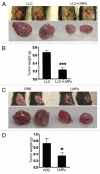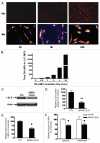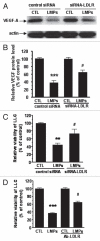Low density lipoprotein receptor mediates anti-VEGF effect of lymphocyte T-derived microparticles in Lewis lung carcinoma cells
- PMID: 20603610
- PMCID: PMC3040968
- DOI: 10.4161/cbt.10.5.12533
Low density lipoprotein receptor mediates anti-VEGF effect of lymphocyte T-derived microparticles in Lewis lung carcinoma cells
Abstract
Nonstop proliferation and vigorous neovascularization are two prominent characteristics of cancer. Antiangiogenic therapy has emerged as an important modality in treatment of solid tumors. Our previous work demonstrated that microparticles derived from apoptotic T-lymphocytes (LMPs) not only reduced the viabilities of high-proliferating cells, but also exhibited potent antiangiogenic effects through inhibition of the vascular endothelial growth factor (VEGF)/VEGF receptor 2 signalling pathway. In the present study, we extended these studies to explore the anticancer potential of LMPs using a murine model of Lewis lung carcinoma (LLC). Results show that intratumoral injection of LMPs (2.5 mg/kg) decreased tumor size by more than 50% relative to control. Tumor microvessel density and VEGF-A levels were also markedly reduced upon LMPs treatment. To elucidate the underlying mechanisms of LMPs-mediated antitumor activity, LLC cells were utilized in in vitro experiments. LMPs suppressed VEGF-A protein levels in LLC cells and led to inhibition of LLC cell viability and proliferation. In addition, knockdown of the low-density lipoprotein receptor (LDLR) expression reduced the uptake of LMPs into LLC cells and attenuated the inhibitory effects of LMPs on cell growth and VEGF-A expression. Our findings demonstrate that LMPs exert antiangiogenic and proapoptotic effects that lead to inhibition of lung carcinoma by reducing VEGF-A levels and LDLR mediates the anti-VEGF effect of LMPs through translocating LMPs into LLC cells. These results suggest that LMPs are promising antiangiogenic therapeutic agent and represent a new therapeutic strategy for treating lung carcinomas.
Figures






Similar articles
-
Role of receptor-mediated endocytosis in the antiangiogenic effects of human T lymphoblastic cell-derived microparticles.Am J Physiol Regul Integr Comp Physiol. 2012 Apr 15;302(8):R941-9. doi: 10.1152/ajpregu.00527.2011. Epub 2012 Feb 15. Am J Physiol Regul Integr Comp Physiol. 2012. PMID: 22338082
-
Ginkgo biloba exocarp extracts inhibits angiogenesis and its effects on Wnt/β-catenin-VEGF signaling pathway in Lewis lung cancer.J Ethnopharmacol. 2016 Nov 4;192:406-412. doi: 10.1016/j.jep.2016.09.018. Epub 2016 Sep 17. J Ethnopharmacol. 2016. PMID: 27649680
-
Lymphocytic microparticles inhibit angiogenesis by stimulating oxidative stress and negatively regulating VEGF-induced pathways.Am J Physiol Regul Integr Comp Physiol. 2008 Feb;294(2):R467-76. doi: 10.1152/ajpregu.00432.2007. Epub 2007 Nov 28. Am J Physiol Regul Integr Comp Physiol. 2008. PMID: 18046016
-
Bee venom inhibits tumor angiogenesis and metastasis by inhibiting tyrosine phosphorylation of VEGFR-2 in LLC-tumor-bearing mice.Cancer Lett. 2010 Jun 1;292(1):98-110. doi: 10.1016/j.canlet.2009.11.013. Epub 2010 Feb 25. Cancer Lett. 2010. PMID: 20188461
-
Research progress of siVEGF complex and their application in antiangiogenic therapy.Int J Pharm. 2023 Aug 25;643:123251. doi: 10.1016/j.ijpharm.2023.123251. Epub 2023 Jul 20. Int J Pharm. 2023. PMID: 37481098 Review.
Cited by
-
Lymphocytic Microparticles Modulate Angiogenic Properties of Macrophages in Laser-induced Choroidal Neovascularization.Sci Rep. 2016 Nov 22;6:37391. doi: 10.1038/srep37391. Sci Rep. 2016. PMID: 27874077 Free PMC article.
-
Microvesicles in Atherosclerosis and Angiogenesis: From Bench to Bedside and Reverse.Front Cardiovasc Med. 2017 Dec 18;4:77. doi: 10.3389/fcvm.2017.00077. eCollection 2017. Front Cardiovasc Med. 2017. PMID: 29326946 Free PMC article. Review.
-
A bioinformatics investigation into the pharmacological mechanisms of javanica oil emulsion injection in non-small cell lung cancer based on network pharmacology methodologies.BMC Complement Med Ther. 2020 Jun 5;20(1):174. doi: 10.1186/s12906-020-02939-y. BMC Complement Med Ther. 2020. PMID: 32503508 Free PMC article.
-
The Emerging Roles of Microparticles in Diabetic Nephropathy.Int J Biol Sci. 2017 Sep 5;13(9):1118-1125. doi: 10.7150/ijbs.21140. eCollection 2017. Int J Biol Sci. 2017. PMID: 29104503 Free PMC article. Review.
-
Cancer Patient-Derived Circulating Microparticles Enhance Lung Metastasis in a Rat Model: Dual-Source CT, Cellular, and Molecular Studies.Mol Imaging Biol. 2016 Aug;18(4):490-9. doi: 10.1007/s11307-015-0923-8. Mol Imaging Biol. 2016. PMID: 26669780
References
-
- Hugel B, Martinez MC, Kunzelmann C, Freyssinet JM. Membrane microparticles: two sides of the coin. Physiology (Bethesda) 2005;20:22–27. - PubMed
-
- Meziani F, Tesse A, Andriantsitohaina R. Microparticles are vectors of paradoxical information in vascular cells including the endothelium: role in health and diseases. Pharmacol Rep. 2008;60:75–84. - PubMed
-
- Yang C, Mwaikambo BR, Zhu T, Gagnon C, Lafleur J, Seshadri S, et al. Lymphocytic microparticles inhibit angiogenesis by stimulating oxidative stress and negatively regulating VEGF-induced pathways. Am J Physiol. 2008;294:467–476. - PubMed
-
- Folkman J. Tumor angiogenesis: therapeutic implications. N Engl J Med. 1971;285:1182–1186. - PubMed
-
- Hanahan D, Folkman J. Patterns and emerging mechanisms of the angiogenic switch during tumorigenesis. Cell. 1996;86:353–364. - PubMed
Publication types
MeSH terms
Substances
Grants and funding
LinkOut - more resources
Full Text Sources
